Looking for graphic evidence
Editor's note: Kevin M. Waters is president and COO of The National Food Lab, Livermore, Calif.
When you were growing up, did anyone ever tell you not to judge a book by its cover? It might have pertained to meeting a new kid on the block or forming an opinion based on what someone was wearing. In either scenario, you were probably told that it was wrong, or premature, to form opinions about such things without first understanding, experiencing or knowing more about the person. This may have been sage advice in the context of the above but it’s not the best mantra when thinking about today’s world of consumer packaged goods – especially when one considers a product’s packaging.
There are all kinds of data, and even more opinions, about how many purchase decisions are made spontaneously, often right in the store aisle in front of the shelf. Graphic design firms speak, rightly so, about the need for visibility on the shelf or the ability for a package’s graphics (or structure) to stand out in a crowded section and catch the eye of the potential buyer – a first moment of truth.
The package’s graphics then need to quickly communicate something enticing about the product inside to encourage the shopper to pick the product up, with an eventual end-goal of purchasing it. This is especially true for first-time buyers of said product, who have not been, or only minimally been, exposed to any advertising or messaging beyond the package itself. It’s this exact scenario where the advice you probably received when growing up falls short, for shoppers are doing exactly what the advisors told us we should not do – judging a product by its package.
This book-cover analogy is a two-way street in the world of packaged goods. There are lots of good covers (packages) on the shelves that will drive purchase and trial yet fall short with repeat purchase because of flaws in the book (the product) – not a good situation for the brand or business manager. Similarly, there are lots of great books (products) that will lag in purchase interest because their covers (packages) aren’t working as hard or effectively to draw the buyer in – again not what a brand or business manager wants. Finding the right package-to-product fit thus becomes essential in eliminating these situations and optimizing brand alignment across two very important interaction points.
Variables need to be isolated
Product testing, generally in a blind or unbranded manner (i.e., without influence of brand or brand elements such as packaging), is critical to understanding just how good your actual product is. Marketers need to understand this element of the mix and should invest in proper guidance testing techniques to isolate product as a variable and gain such knowledge. At the same time, an understanding of the impact of the package and brand on the product is important, and these variables need to be isolated as well. Bundling tests or research to get at the whole picture is important but it often fails to catch the nuances of how a package and product interact and fit – or don't – with each other, simply because of failure to isolate these important pieces of the mix.
There are several ways to isolate package and product performance but the most straightforward approach is to consider a split-cell test design, where a matched group (or cell) of target respondents (in this case, a user of your brand or possibly a broader group of category users of the product) react to one of the two scenarios. For example, the first group (Cell 1) evaluates just the product by itself (i.e., blind, with no reference to brand or packaging), and the second group (Cell 2) evaluates the product when seen in the context of the packaging (i.e., branded).
Table 1 is a basic example of output from a split-cell design, where, in this case, each cell is evaluated on a common set of metrics related to the brand (e.g., key product attributes or benefits). Comparing results across the two cells shows how and where the scenarios differ, thus arming a marketer with important information about their brand and what can be leveraged versus what requires potential improvement attention.
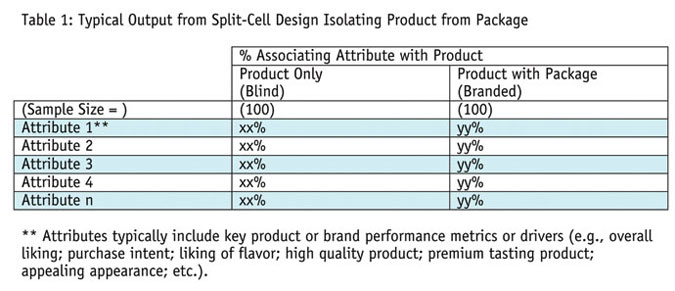
The above output typically has one of three outcomes:
Package/product fit: Essentially no difference between cells across key attributes and performance metrics. The brand interaction points appear to be working in concert.
Product under-delivering: The branded scenario (i.e., package with product) showing advantages over the blind scenario (i.e., product by itself, with no package or brand influence). The brand interaction points are not working in concert. Deficiencies with the product may exist and may deter repeat purchases if not reformulated.
Package under-delivering: The blind scenario (i.e., product by itself) showing advantages over the branded scenario (i.e., package with product). The brand interaction points are not working in concert. Deficiencies with the package may be prohibiting initial trial of the product by failing to effectively communicate true product strengths.
Now let’s examine how to extract insights and apply action to these scenarios.
Package/product fit
Generally speaking and under most scenarios, a similar data profile for key attributes between blind (i.e., product only) and branded (i.e., product in the context of the package) evaluations of a product suggests a fit between these two brand interaction points. Using our analogy from before, this equates to a book that has met expectations generated by its cover. Marketers should seek such findings because they reveal that two primary brand interaction points are delivering similar perceptions to the target shopper and consumer. Said another way, the interaction points are aligned and are supporting desired brand benefits.
Table 2 provides a hypothetical data set for this scenario. In this example, we see that five key brand attributes for a Mexican entrée show comparable ratings across the two brand interaction points. The manager of this brand can feel confident that expectations emerging from the entrée’s packaging have been delivered upon by the actual product.
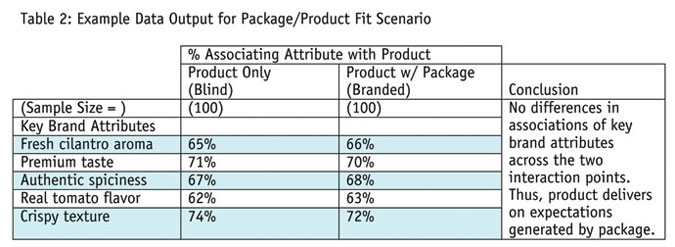
While simplified, the above scenario is a key step in assessing brand alignment between a product and its packaging. While it’s important to look for differences or patterns of variance between the two cells, it’s also necessary to assess the absolute value/magnitude of the data to capture how well (or not) a specific interaction point is performing. In a similar context, augmenting such research with appropriate tests versus the competition should also be considered to provide a read on how each interaction point (i.e., the product and the packaging) fares versus the primary competitors. Tests such as the latter provide obvious cues which can lead to or confirm desired positioning priorities and messaging to be incorporated into and across brand interaction points.
Product under-delivery
A brand’s package is often the most critical marketing vehicle that consumers will be exposed to and/or aware of, and this is especially true during shopping situations at store shelves. The package, especially for first-time buyers of a brand, communicates something about the product in a meaningful way, and in that context it creates an expectation or a promise. When a product fails to deliver on key dimensions, that promise is broken. Going back to our earlier analogy, this equates to a book that has fallen short of expectations generated by the cover.
The implication in this scenario is that the package may in fact be successful at spurring initial purchase or trial, but repeat purchase of the brand may be in jeopardy because the product fails to live up to key expectations.
Table 3 depicts typical output of a product that under-delivers on some key brand attributes, again for a Mexican entrée. Specifically, the product fails to deliver on some key aroma and flavor characteristics, especially those that connote freshness, authenticity/realness and premium nature. For some brands this may not be an issue, but for those that have declared such items as key brand components – and reflected them as such in the brand’s package – it becomes a liability. Failure to address them undermines efforts to align a brand across key interaction points. Reformulation of the product, focused on these areas, should be pursued.

Package under-delivery
The opposite scenario from the above is, of course, when a product seems to over-deliver on key brand attributes that are not properly, or optimally, reflected via its packaging. Using our analogy once again, this equates to a cover that fails to adequately support the content of the book.
Though of less concern versus the prior scenario, the main implication now is that sales may be hindered because the current package is failing to spur interest and drive demand around strong points of the product. This creates an opportunity for the marketer to better align key brand interaction points by focusing on a main marketing vehicle – in this case the package’s graphics – and redesigning it to emphasize key (and known) product advantages. It also creates a potential scenario where a previously unknown leverage point could become a new strategic impetus for the brand, thus opening the door for a potential restage. In either case, understanding these dynamics can help in honing or identifying future opportunities for a brand.
Table 4 contains data from a scenario where a package under-delivers on key strengths of our same Mexican entrée product. As depicted below, the product is associated with key appearance and texture advantages that do not appear to be optimally reflected by the product’s packaging. While flavor perceptions seem consistent between the two cells, the package’s failure to capitalize on the appearance and texture advantages may diminish the overall appeal for the brand at the point of sale, and thus in alignment across key touchpoints.
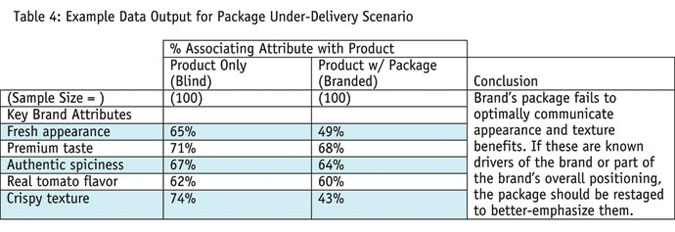
More pieces to the puzzle
Brands today stretch across numerous interaction or touchpoints. While the above focused on two very critical points, there are certainly more pieces to the brand puzzle and the quest to assess all to better understand and control total brand alignment. Taking it to this level, a specific example and question is: What does the total brand stand for? In this context, and in addition to the packaging and the product, we could consider a brand’s Web site, certain major brand advertisements or campaigns (regardless of medium) or various brand promotions, to name a few. Linking these points and assessing broader brand alignment should begin with, simply, the brand. In this context, brand is often presented as a specific and separate test cell and other interaction or touchpoints get compared to this baseline cell to ascertain which points generally meet, exceed or fall short of the desired brand profile. Table 5 represents a simplified summary of such analyses.
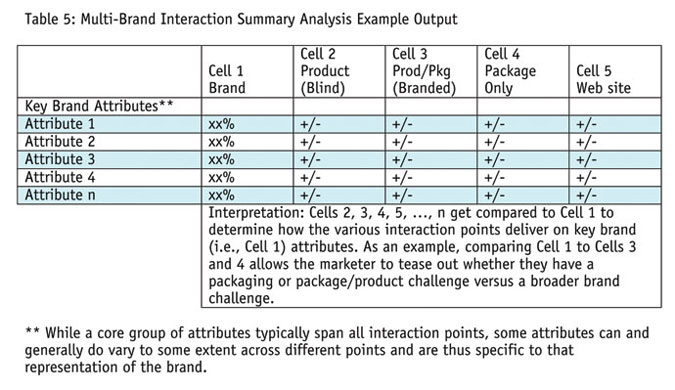
A manager’s ability to understand and optimize each brand interaction or touchpoint so that they reinforce known or key brand elements ultimately guards the brand against liabilities or deficiencies. Periodically conducting split-cell tests such as those summarized above can provide the prescriptive data needed to understand such nuances (see Table 6 for key summary points). In particular, the analyses are especially critical for a brand’s packaging and the actual product, two key points that strongly influence both trial and repeat purchases.
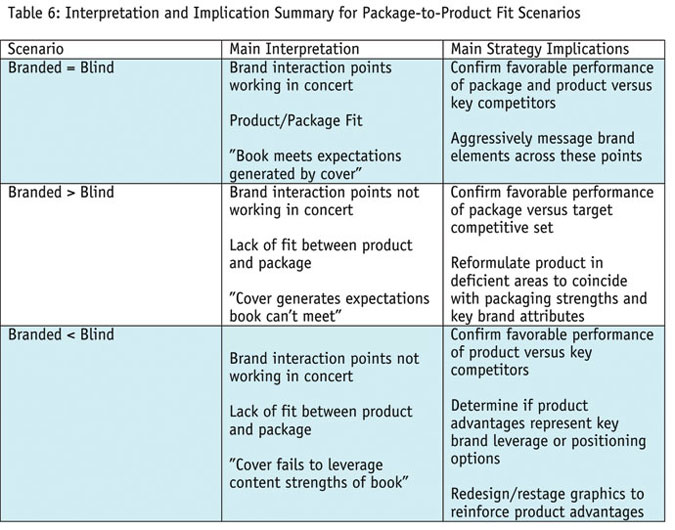
The next time someone asks you whether people judge a book by its cover, think about the question in the context of your brand – and then ask yourself if you can conclusively state how your brand cover and book relate to one another.
